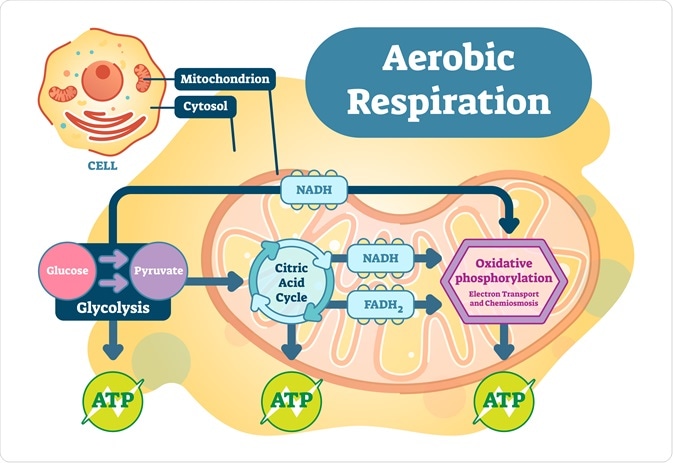Glycolysis is a term used to describe the metabolic pathway involving the degradation of glucose into pyruvate and energy used to form adenosine triphosphate (ATP) and reduced nicotinamide adenine dinucleotide (NADH).
The pathway occurs in nearly all organisms and is independent of oxygen, although the products of glycolysis are sometimes decomposed with the help of atmospheric oxygen.
The following equation summarizes the series of reactions that occur in the glycolysis pathway:
C6H12O6 + 2 NAD+ + 2 ADP + 2 P –> 2 pyruvic acid, (CH3(C=O)COOH) + 2 ATP + 2 NADH + 2 H+
There are a number of steps that are required to take place in order for glycolysis to take place, which can be divided into two main sections: preparatory phase and pay off phase.
 Infographic of aerobic respiration and the process of glycolysis. Image Credit: VectorMine / Shutterstock.com
Infographic of aerobic respiration and the process of glycolysis. Image Credit: VectorMine / Shutterstock.com
Preparatory Phase
Also known as the investment phase, the preparatory phase involves the consumption of the ATP to initiate the metabolic process. The following steps are included in this phase:
1. Phosphate ester synthesis: An endothermic reaction catalyzed by hexokinase uses energy from ATP to synthesize a phosphate ester to the glucose molecule at the C-6 position.
2. Isomerization: A reaction catalyzed by phosphoglucoisomerase transforms the glucose-6-phosphate into an isomer, fructose-6-phosphate.
3. Phosphate ester synthesis: An endothermic reaction catalyzed by phosphofructokinase uses energy from ATP to synthesize a phosphate ester to the fructose-6-phosphate molecule at the C-1 position.
4. Split molecule: The fructose-1,6-diphosphate molecule undergoes a reverse aldol condensation reaction catalyzed by aldolase to form two carbon compounds, an aldehyde and a ketone.
Of the two dihydroxyacetone phosphate molecules formed in this split, one continues into the pay off phase immediately, and the other undergoes another reaction and then moves into the second phase. The final step is:
5. Isomerization: A reaction catalyzed by triose phosphate isomerase transforms the dihydroxyacetone phosphate to glyceraldehyde-3-phosphate.
Pay Off Stage
At the conclusion of the reactions in the preparatory phase, the pay off phase can begin and follow through to completion twice, first with the glyceraldehyde molecule and then with the glyceraldehyde-3-phosphate molecule. The reactions are as follows:
1. Phosphate ester synthesis: an oxidation reaction of the aldehyde catalyzed by glyceraldehyde-3-phosphate leads to the formation diphosphoglycerate.
2. Hydrolysis of phosphate: a hydrolysis reaction catalyzed by phosphoglycerol kinase forms an acid, a phosphate ion and ATP.
3. Isomerization: the movement of the phosphate group catalyzed by phosphoglycerate mutase occurs from position 3 to position 2.
4. Alcohol dehydration: a dehydration reaction catalyzed by enolase removes the alcohol (-OH) and the (-H) from the C-3 and C-2 carbons.
5. Phosphate ester hydrolysis: the final hydrolysis reaction catalyzed by pyruvic kinase stabilizes the molecule and forms the acid, a phosphate ion and ATP.
At the conclusion of the pay off stage, the glycolysis pathway is complete.
References
- http://www.ncbi.nlm.nih.gov/books/NBK22593/
- http://vcell.ndsu.edu/animations/glycolysis_overview/first.htm
- http://www.uic.edu/classes/bios/bios100/lectures/respiration.htm
- http://chemistry.elmhurst.edu/vchembook/601glycolysisrx.html
Further Reading
- All Glycolysis Content
- What is Glycolysis?
- Krebs Cycle Overview
Last Updated: Jan 26, 2021

Written by
Yolanda Smith
Yolanda graduated with a Bachelor of Pharmacy at the University of South Australia and has experience working in both Australia and Italy. She is passionate about how medicine, diet and lifestyle affect our health and enjoys helping people understand this. In her spare time she loves to explore the world and learn about new cultures and languages.
Source: Read Full Article
